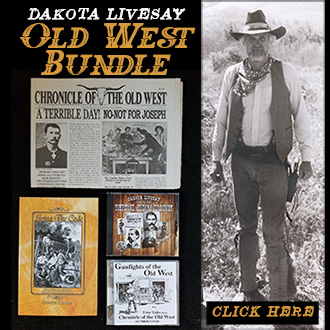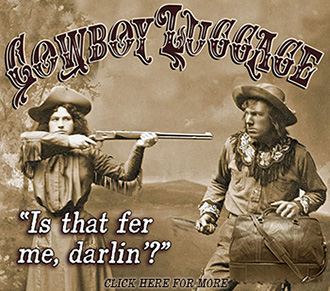 The amazing story of Agnes Lake Hickok, the wife of Wild Bill Hickok, appears for the first time in this wonderfully written and carefully researched volume. Beginning with the early life of the girl born in Germany in 1826, the book tells how Agnes Messmann immigrated to the United States after a long ocean voyage. Some family members died during the harrowing trip, but the rest eventually arrived at a German-speaking community north of Cincinnati, Ohio where they farmed.
The amazing story of Agnes Lake Hickok, the wife of Wild Bill Hickok, appears for the first time in this wonderfully written and carefully researched volume. Beginning with the early life of the girl born in Germany in 1826, the book tells how Agnes Messmann immigrated to the United States after a long ocean voyage. Some family members died during the harrowing trip, but the rest eventually arrived at a German-speaking community north of Cincinnati, Ohio where they farmed.
At age twelve, Agnes witnessed her first circus. After a sixteen-mile trip to town by wagon, the family was entertained by an elephant, an animal act featuring lions and leopards, trick dogs, an Indian rubber man, clowns and dancing horses. Apparently this event impressed young Agnes so much that by her 19th birthday she declared her independence and eloped with a circus man named William Lake she met when another circus came to her hometown.
Against her family’s wishes, Agnes took up the grueling, albeit exciting life of a circus performer. For nearly forty years the couple criss-crossed the eastern and southern United States working for a variety of circuses. Lake himself had done equestrian acts, plus tricks and stunts with dogs and other animals, but he was primarily known for his clown act. The Lakes even crossed the Atlantic to perform one season in Germany. Back in America, Agnes was famous for her equestrienne “high school” routines riding highly trained horses, as well as her daring feat as a slack-wire walker. Later, she worked as an animal trainer with lions and tigers. Her daughter became famous as an expert circus equestrienne, too. Agnes raised several children, and experienced the tragic deaths of two infants. She understood the hard days of constant travel by wagon and later by train. The shocking death of her husband at the hand of a murderer, tossed her into the position of running the circus by herself for several seasons.
In Abilene, Kansas, Agnes now widowed, met the dashing bachelor and town marshal known as Wild Bill Hickok. Various versions of this encounter include the two people being instantly attracted to one another. However, it was five years later when they met again, and married on March 5, 1876. Their union has always been a curiosity since Hickok was an avowed bachelor, and Agnes was much older than him. Shortly after their marriage, Hickok ventured to the Black Hills to make arrangements for the couple to settle on a ranch when he was murdered in August of 1876 in a Deadwood barroom while playing cards.
This is where popular history and Agnes Lake Hickok part company. When he was killed, Wild Bill was already a legend in the west. Since he had been acquainted with Calamity Jane, novelists and newspaper writers were quick to team those two up romantically. In reality, it is highly unlikely that Wild Bill and Calamity had any serious personal relationship. Calamity Jane was a rollicking drunkard who made up enormous lies about herself, and Wild Bill was never known to consort with lewd women. However, dime novels, plays, and eventually Hollywood movies found wonderful grist for their mill, thus Agnes was forgotten in connection with the life of Wild Bill.
Be that as it may, Wild Bill and Calamity rest in peace a few yards away from each other as a tourist attraction in a Deadwood cemetery. Agnes died of old age in 1907, and rests in the family plot in Cincinnati, Ohio beside her first husband.
Agnes is seldom mentioned in connection with Wild Bill, but she had tremendous strength and fortitude and was one of the most admired circus performers of her day. Bill and Agnes Lake’s Hippo-Olympiad and Mammoth Circus was one of the largest traveling tent shows in the United States. It boasted of 240 men and horses and over the years entertained millions of people across the country. Known as the “Circus Queen,” with or without Wild Bill, Agnes Lake Hickok is a legend in her own right. You can find out more by grabbing this book HERE.
Editor’s Note: The reviewer, Phyllis Morreale-de la Garza is the author of numerous books including the novel Silk and Sagebrush; Women of the Old West,, published by Silk Label Books, P.O. Box 700, Unionville, New York 10988-0700
*Courtesy of Chronicle of the Old West newspaper, for more click HERE.


 Six months after a member of his own gang shot Jesse James in the back, and after committing at least twenty robberies, on October 5, 1882, Frank James, Jesse’s brother surrendered to Missouri governor Thomas Crittenden.
Six months after a member of his own gang shot Jesse James in the back, and after committing at least twenty robberies, on October 5, 1882, Frank James, Jesse’s brother surrendered to Missouri governor Thomas Crittenden. Governor Crittenden had replied that he could not give amnesty… but if Frank James went on trial and was convicted, he could give him a pardon.
Governor Crittenden had replied that he could not give amnesty… but if Frank James went on trial and was convicted, he could give him a pardon.
 In the early 1800’s the Southwest was part of Mexico, and Mexico was under the domination of Spain. Because the Spanish were afraid of the expansion of the Anglos, they closed the area to anyone from the states. Any American trader they found in the area ended up in jail.
In the early 1800’s the Southwest was part of Mexico, and Mexico was under the domination of Spain. Because the Spanish were afraid of the expansion of the Anglos, they closed the area to anyone from the states. Any American trader they found in the area ended up in jail.




